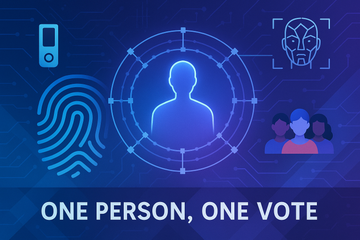Picture this—you’re hanging out in your favorite online crypto community, surrounded by usernames and a swarm of wallets. Who’s real? Who’s a bot or a clever fraudster? That’s not just small talk; it’s a big problem for blockchain networks. Enter Proof of Personhood (PoP), a fresh idea that’s quietly shaking up how we tell real people apart from digital tricksters.
What’s PoP Anyway? It’s Not Just Another Acronym
Here’s the thing: most blockchains use methods like Proof of Work (let those mining rigs whir!) or Proof of Stake (bigger wallets, bigger clout) to reach consensus—basically, to make sure everyone plays by the rules. But those systems never ask: “Hey, are you even a real person?” PoP does exactly that. It focuses on verifying one uniquely human being per account, so a single person can’t pretend to be 100 different voters. It’s a simple question with a not-so-simple answer—how do you prove to a network of strangers that you’re not a bot, without giving up your privacy?
Why Everyone’s Buzzing About PoP—And Why Some Folks Are Nervous
Honestly, the biggest reason PoP is gaining traction is the rampant fear of Sybil attacks—that’s jargon for fraudsters making a bunch of fake identities to mess up voting, corner token rewards, or just muck about in communities [CoinMarketCap]. The old models weren’t built for this. So, PoP takes a detour. It leans on the fact that you, warm-blooded reader, are unique. The logic is remarkably democratic: one person, one vote. No room for duplicate accounts or AI armies.
But wait. With great power comes, well, a truckload of privacy questions. How do you stop fraud while still protecting folks’ identities? Let’s unpack that.
Proof, Please: How PoP Tries to Sort People from Pretenders
1. In-Person “Pseudonym Parties”—Yes, Really
Some projects get a bit old school, throwing block party-style meetups (called pseudonym parties). You show up, prove you’re not three bots in a trench coat, then walk away with a unique digital stamp. One project called Encointer is pioneering these, scheduling random group meetups in cities worldwide. But, let’s be real, not everyone wants to schlepp across town just to register for a digital system [Wikipedia].
2. Social “Web of Trust”—Let Your Friends Vouch for You
Other folks skip the commute and use social network attestations. Think of it like a digital background check—your friends or connections vouch that you’re real. Projects like UniqueID lean heavily on network-backed verification and biometrics (like facial recognition) to make sure nobody’s gaming the system with sockpuppets [Identity Management Institute].
- Biometric scans—face, iris, or voice recognition. (Iron Man not required.)
- ID checks—government-issued IDs matched to your online persona.
- Behavioral patterns—analyzing wallet activity or transaction patterns to weed out suspect accounts.
Still, social proof isn’t flawless. It struggles to spot well-organized small-scale fraud or attackers who slip past network connections by exploiting group psychology. Digital trust is messier than it sounds.
The Ledger, Trezor, and Hardware Wallet Angle: What’s in It for You?
Now, if you’re like most crypto holders, you’ve heard advice on hardware wallets—keep your stash on devices like Ledger or Trezor to stay safe. But here’s a twist: PoP could work hand in hand with these wallets. Imagine a world where you can sign a transaction, prove your human uniqueness through your wallet, and participate in governance, all while knowing the network isn’t being gamed by bots [Ledger].
Suppose the only way to register for a governance vote is to pair human proof (like a biometric scan or social attestation) with a hardware wallet signature. Suddenly, fake identities hit a brick wall. The blend of digital wallet security and PoP’s focus on the “humanness factor” might just be the next leap in keeping blockchains truly decentralized.
Taking Sides: PoP vs. Proof of Stake/Work—The Showdown
If PoP feels weirdly personal, that’s because it is. Unlike Proof of Work (which rewards bulk computing) or Proof of Stake (biggest wallet wins), PoP says, “It doesn’t matter how rich or techy you are—if you’re a real human, you count.” This flips traditional power structures on their head. Everyone gets a fairer shot at participating, whether they own a single token or a crypto fortress.
Granted, PoP isn’t perfect. It can be tedious to coordinate global in-person events. Not everyone is thrilled by the idea of scanning their face or sharing bits of personal data, even with privacy protections in place. And, as with everything crypto, there’s always a risk: clever attackers learn new tricks, and no system is ever bulletproof for long.
Wait, Is PoP the Future—or Just a Weird Trend?
Here’s where the conversation gets real. PoP is still pretty experimental. Some projects are using it to protect governance votes, distribute universal basic income tokens, or just keep scams at bay for community membership. But, let’s be honest, most of us aren’t jetting to local pseudonym parties—or eager for iris scans—just yet.
Yet, as AI gets sneakier and fraudsters keep pushing, the need for robust, privacy-respecting human verification won’t go away. Will PoP become the norm, or will it blend quietly with improved KYC, biometrics, and social networks? Only time (and the creativity of crypto communities) will tell.
Wrapping Up: Can We Keep Blockchains Human?
In short: PoP adds a heartbeat to blockchain consensus. It’s about making digital worlds a little more personal, a bit more fair, and a lot better protected against identity fraud. Whether you’re a die-hard hardware wallet fan or a curious crypto newcomer, keep your eye on Proof of Personhood. It might just become the key to keeping communities authentic—and, dare I say, even a little more human.











